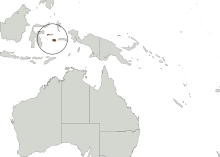Buru babirusa
| Buru babirusa | |
|---|---|

| |
| Skull at the Museum Wiesbaden | |
| Scientific classification | |
| Domain: | Eukaryota |
| Kingdom: | Animalia |
| Phylum: | Chordata |
| Class: | Mammalia |
| Order: | Artiodactyla |
| Family: | Suidae |
| Genus: | Babyrousa |
| Species: | B. babyrussa[1]
|
| Binomial name | |
| Babyrousa babyrussa[1] | |

| |
| Range (in brown) | |
| Synonyms | |
|
Sus babyrussa Linnaeus, 1758 | |
The Buru babirusa (Babyrousa babyrussa) is a wild
In absence of detailed data on the Buru babirusa, it is generally assumed that its habitat and ecology are similar to that of
The north Sulawesi babirusa reach sexual maturity when they are 5–10 months old. Their estrous cycle is 28–42 days, and the gestation period lasts 150–157 days. The females have two rows of teats and will give birth to 1–2 piglets weighing 380–1,050 grams (15–35 oz) and measuring 15–20 cm (6–8 inches), which they will nurse until the age of 6–8 months. The lifespan is about 24 years.[6][5]
The Buru babirusa has been assessed as vulnerable on the IUCN Red List, as its habitat is restricted a total area of 20,000 km2 (7,700 sq mi), and its gradual loss due to logging. Hunting by the local population is another cause of concern. Whereas it is unpopular among Muslim communities for religious reasons, it is widely hunted by the indigenous people of Buru, which are predominantly Christian. The meat of the Buru babirusa has low fat (only 1.27% compared to 5–15% for domestic pigs) and is regarded as a delicacy. It is also preferred by the locals to the meat of other wild pigs or deer in terms of texture and flavor.[2] The establishment of two protected areas on Buru, Gunung Kapalat Mada (1,380 km2 or 530 sq mi) and Waeapo (50 km2 or 20 sq mi), partly aim at preserving the habitat of the Buru babirusa.[7] This species also enjoys full protection under Indonesian law since 1931.[2]
References
- OCLC 62265494.
- ^ . Retrieved 16 January 2022.
- ^ Meijaard, E. & Groves, C. P. (2002). "Upgrading three subspecies of Babirusa (Babyrousa sp.) to full species level". IUCN/SSC Pigs, Peccaries, and Hippos Specialist Group (PPHSG) Newsletter. 2 (2): 33–39. Retrieved 12 March 2023.
- ISBN 978-84-96553-77-4.
- ^ ISBN 978-3-89958-389-2.
- ISBN 0-8014-1753-8.
- ^ "Buru rain forests". Terrestrial Ecoregions. World Wildlife Fund.

